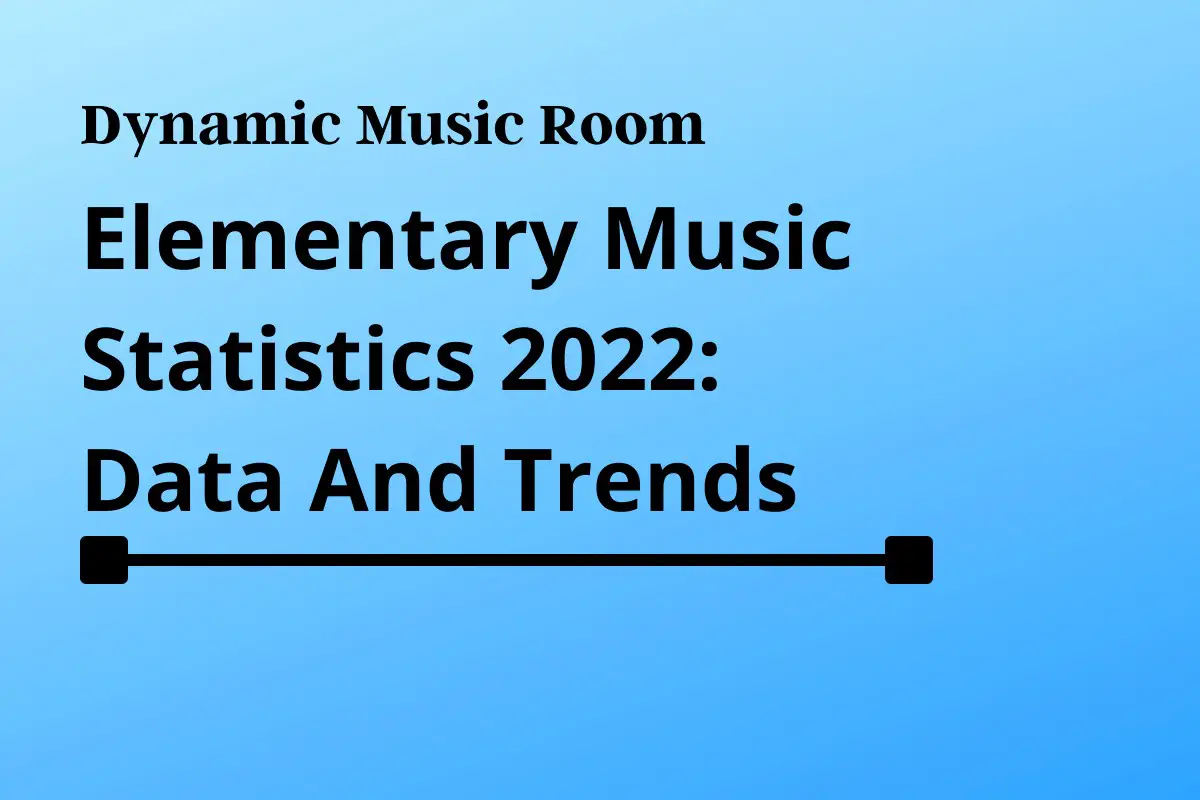I reached out to over 3,000 music teachers to conduct this survey of 11 questions concerning important and relevant topics in our field to answer the question:
What is elementary music and music teaching like right now?
Specifically, I looked at where music is being offered, how well-prepared music teachers are for elementary, job satisfaction, and challenges in the current climate.
In this post, I’ll talk about what I discovered.
Note: Please feel free to share and quote this information. All I ask is you include a link back to the source, either at the homepage or this specific post.
Table of Contents
Summary Of The Most Interesting Findings
1. Teaching music is tough right now, and a surprising number of teachers have seriously considered leaving the profession. 45.5% of music teachers considered leaving the field this year.
2. Most music teachers don’t feel prepared by their college programs to teach elementary music. Only 19.8% feel moderately well-prepared or very prepared for the job.
3. Most students receive 31-45 minutes of music per week (interesting since most state and national standards are based on two 30-minute classes per week). 43.3% of schools offer 31-45 minutes of music per week compared to 35.5% for 46-60 minutes per week.
4. First and Second grades are the most consistent grade levels to receive elementary music, followed closely by Third and Fourth, and then Kindergarten and Fifth grade. 3/4th is 2.1% less likely to have music while Kindergarten is 4.9% less likely and Fifth grade is 13.4% less likely.
5. Most elementary music teachers avoid identifying themselves with a specific method and prefer to use elements of all of them as much as possible. 46% of surveyed music teachers identify with no specific one of the main music methods.
6. Music teachers in the middle of their career (10-20 years) make up a small portion of the professionals still in teaching. 27.3% of current music teachers have between 10-20 years of experience.
7. Just over half of music teachers feel valued while the rest express a lack of appreciation for the work they do. 44.7% say they don’t feel valued at all or only valued as a prep time for teachers.
8. The majority of music teachers (62.3%) are still not getting pulled to sub in classrooms at all. However, the rest range from 1 to over 20 times per year.
9. More music teachers have their Bachelor’s than those who went on to get their Master’s degrees. 51.5% of teachers have a Bachelor’s degree in music vs. 43.9% of those who went on to receive their Master’s degree.
10. Most music teachers see over 300 students in their schools. 41% of music teachers service between 301-500 students, followed closely by 31.2% of teachers in the 501-700 students range.
11. The majority of music teachers still have their own room. 91% of teachers taught in a music room this year compared to 7.6% on a cart and 1.4% in the library.
Have You Considered Leaving The Music Teaching Field?
Teachers seem to be very unsatisfied with their jobs, at least according to the media.
I wanted to see if this claim panned out after surveying other music teachers.
Here’s what I found:
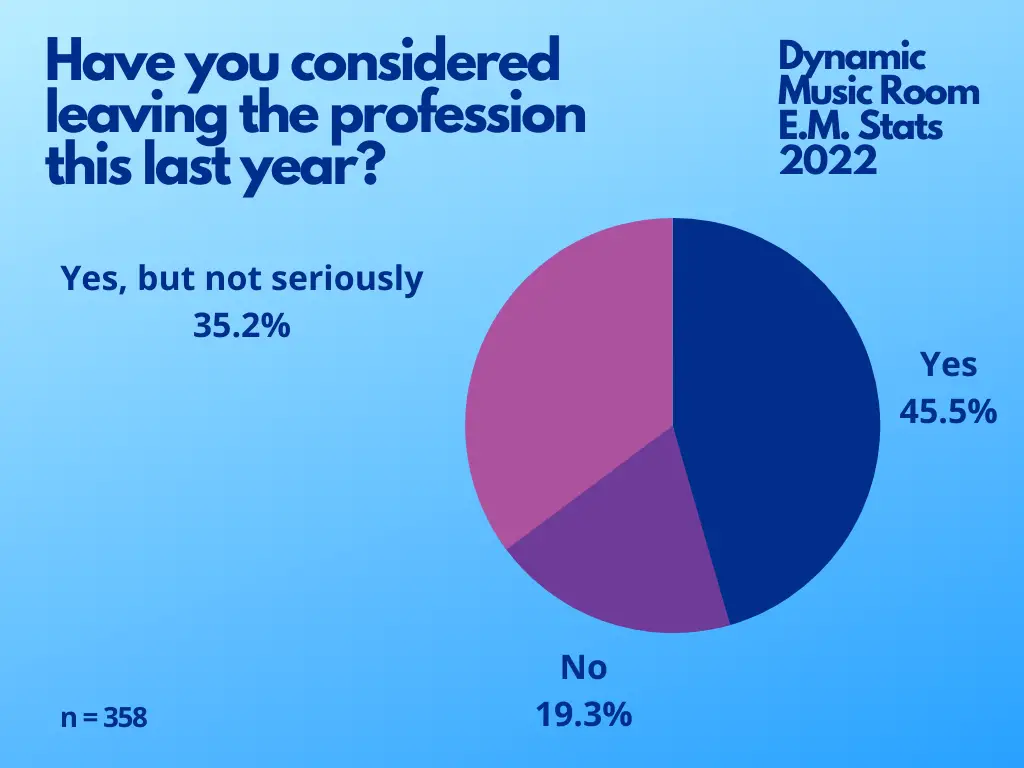
Key Takeaways:
- 45.5% of music teachers seriously considered leaving the music teaching field. This is alarming.
- 35.2% of teachers considered leaving, but not seriously. This number doesn’t scare me as much. I think most people have off days where they wonder about what other professions would satisfy them.
- Only 19.3% of teachers haven’t considered leaving teaching at all. I imagine this number would have been higher in past years. This bears watching over the years for trends.
How Well-Prepared For Elementary Music Did You Feel?
Most university programs offer some classes in elementary music, but they’re often limited in scope compared to the secondary classes they need to take.
I wanted to know how the elementary music community at large felt about their preparation.
Here’s what I found:
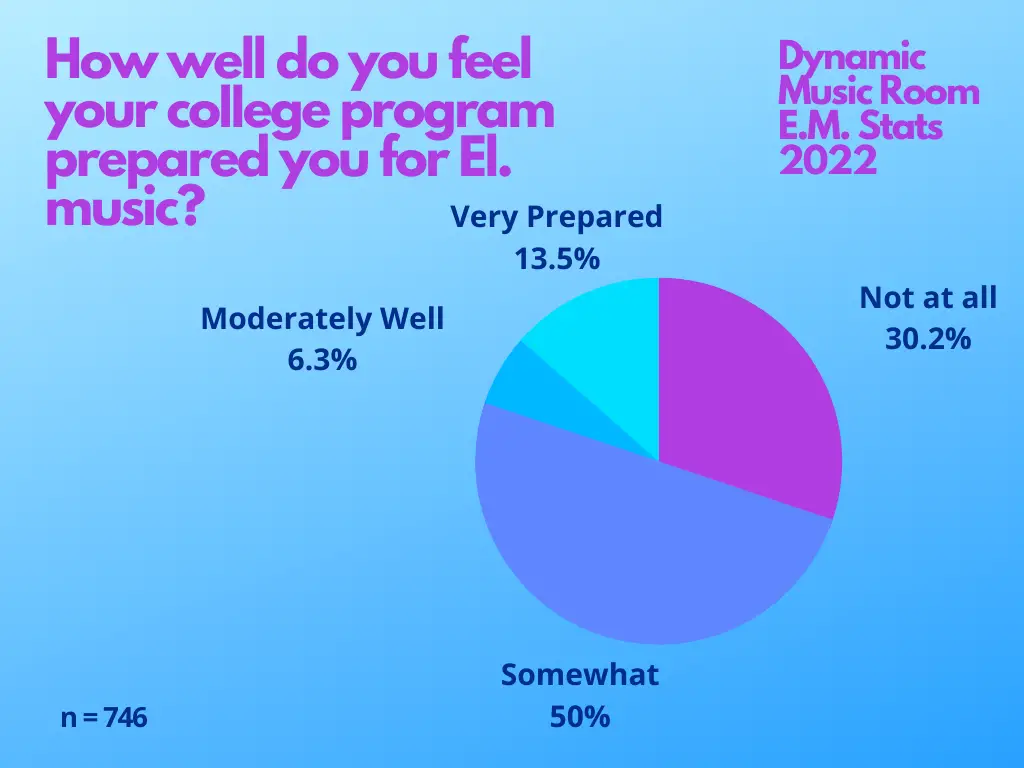
Key Takeaways:
- Most teachers (50%) felt they had some preparation for elementary music. This tracks with the expectation that most college programs offer a class or two in elementary music.
- Few teachers felt moderately prepared (6.3%) or well-prepared (13.5%) for elementary music.
- Some teachers didn’t feel prepared for elementary music at all (30.2%).
- One respondent suggested these feelings may have been due to students not intending to teach elementary during their training. I would add that most music teachers probably student teach in secondary as well, giving them very little practical experience in the field before ending up teaching it for whatever reason.
How Many Minutes Per Week Do Your Students Get Music? (On Average)
I have long suspected a shift in what has been done for music in the past to what is being done now.
I reached out to music teachers about how often their kids get music.
Note: These are minutes on average; some schools may hit this number by having multiple classes per week while others may have a rotation.
The average per week should give us an idea of how much music is happening.
Here’s what I found:
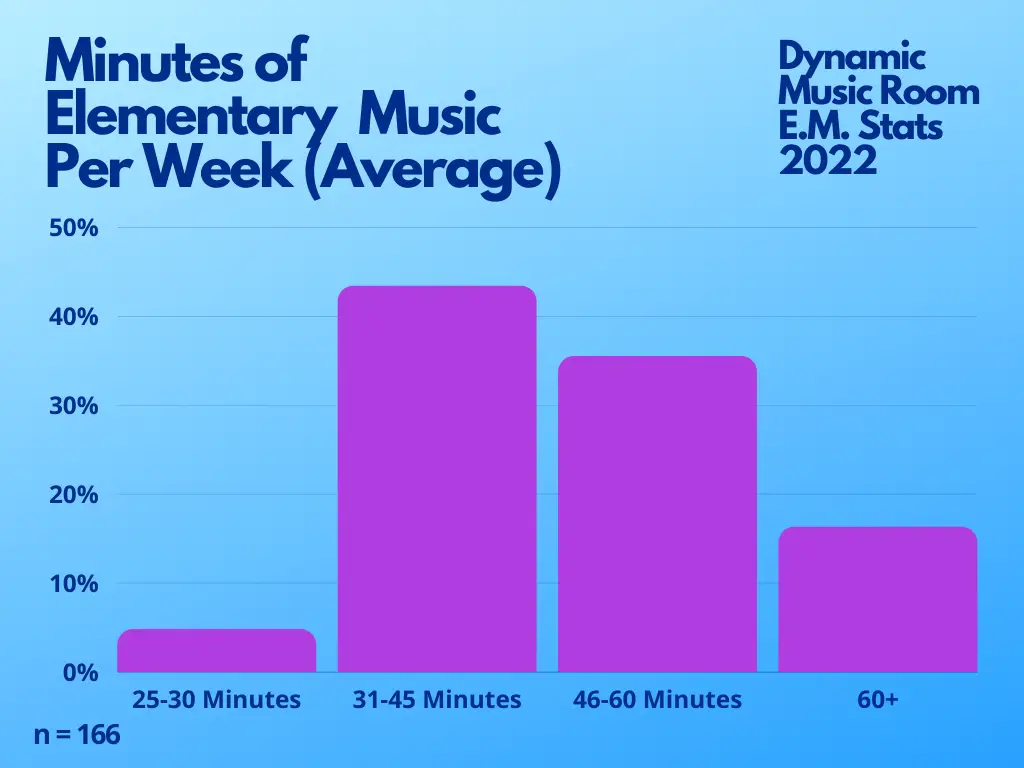
Key Takeaways:
- The most common amount of music per week is in the 31-45 minute range (43.3%). This is the statistic that catches my attention the most here. Most curriculum and materials are still somewhat based on the 30-minutes twice per week music schedule of decades ago. This clearly indicates our materials and pacing don’t match reality.
- This stat bears watching over the next few years to see if changes or cutting in music occur.
Which Grade Levels Receive General Music?
I’ve taught at several schools over the years, and the music offered at each one was different in terms of what grade levels got music.
I wanted to know more about who actually receives general music instruction, and if there were any trends to be aware of around this area.
Here’s what I found:
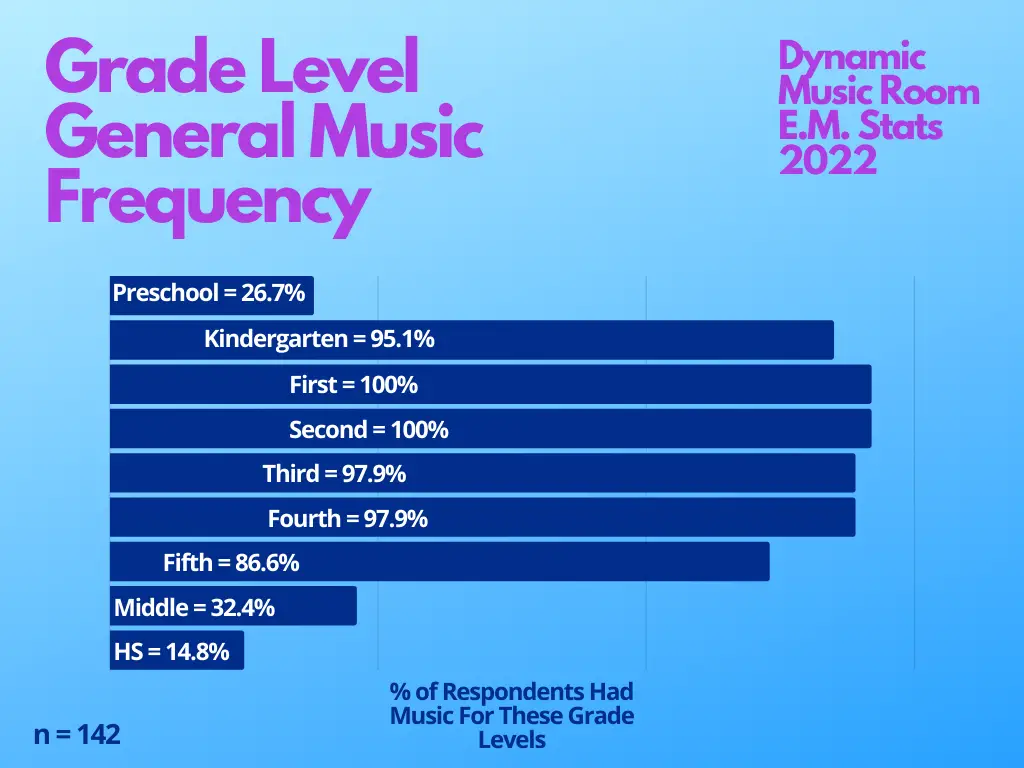
Key Takeaways:
- Preschool gets little music compared to other grade levels (26.7% of respondents). With more and more preschool programs coming into schools, this is an area of potential advocacy.
- Kindergarten gets less music than other grade levels (95.1% of the respondents have music in Kindergarten).
- Fifth grade gets music even less often than the other elementary grades (86.6%).
- Middle School and High School general music classes are a rarity (32.4% and 14.8% respectively). This is expected, but the middle school number being this high is somewhat surprising.
What Method Do You Identify With Most?
In elementary music methods classes, we are taught about specific music methods, but I wanted to see if those were still popular today and how music teachers in the thick of things associate with them.
Here’s what I found:
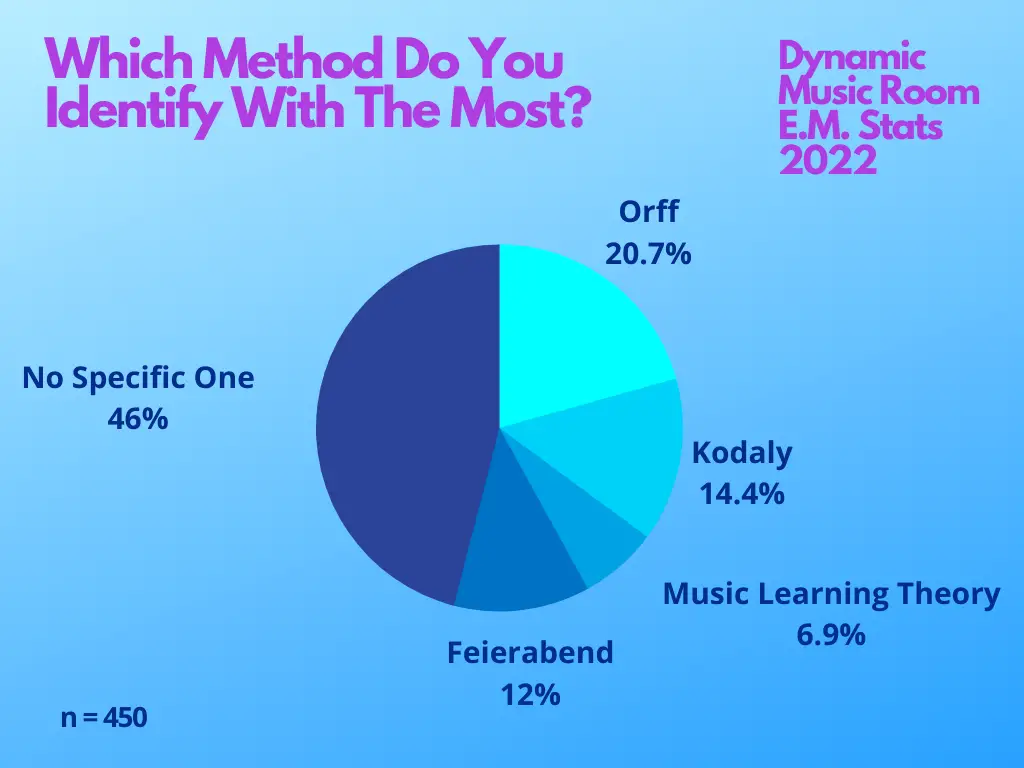
Note: I did ask for Dalcroze as well, but not one of the 450 respondents identified with this method.
Key Takeaways:
- Most music teachers (46%) don’t identify with a specific method. Many respondents added that they prefer to use what works for their students, and it varies based on grade level and time of year.
- Orff-Schulwerk is the most common single method (20.7% of surveyed teachers).
- Kodaly (14.4%) and Dr. Feierabend’s methods (12%) are the next most common.
- Music Learning Theory remains relatively rare in the community at large (6.9%).
I also surveyed music teachers specifically in my home state of Michigan to see if geographic location impacts responses.
In my state, we have a couple of universities with Music Learning Theory programs, several Orff chapters, a single Kodaly chapter, and an active FAME (Feierabend) chapter.
Here’s the comparison:
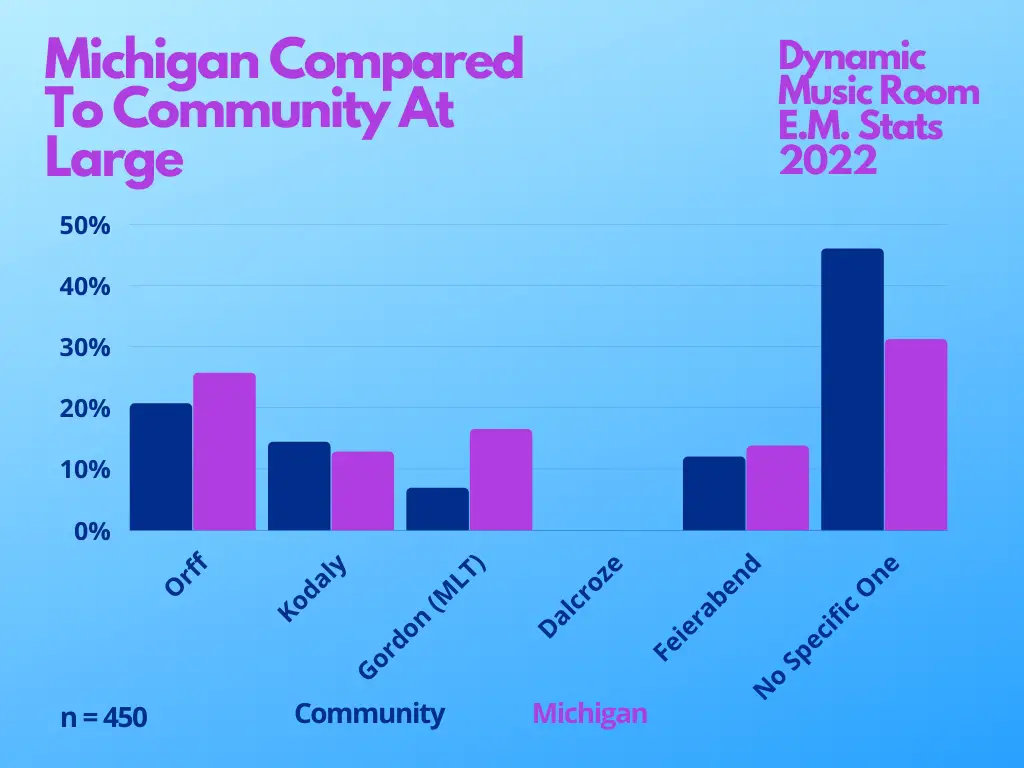
How Long Have You Been Teaching?
In a survey of 906 music teachers, we asked them how many years they’ve been teaching.
The following chart shows the results.
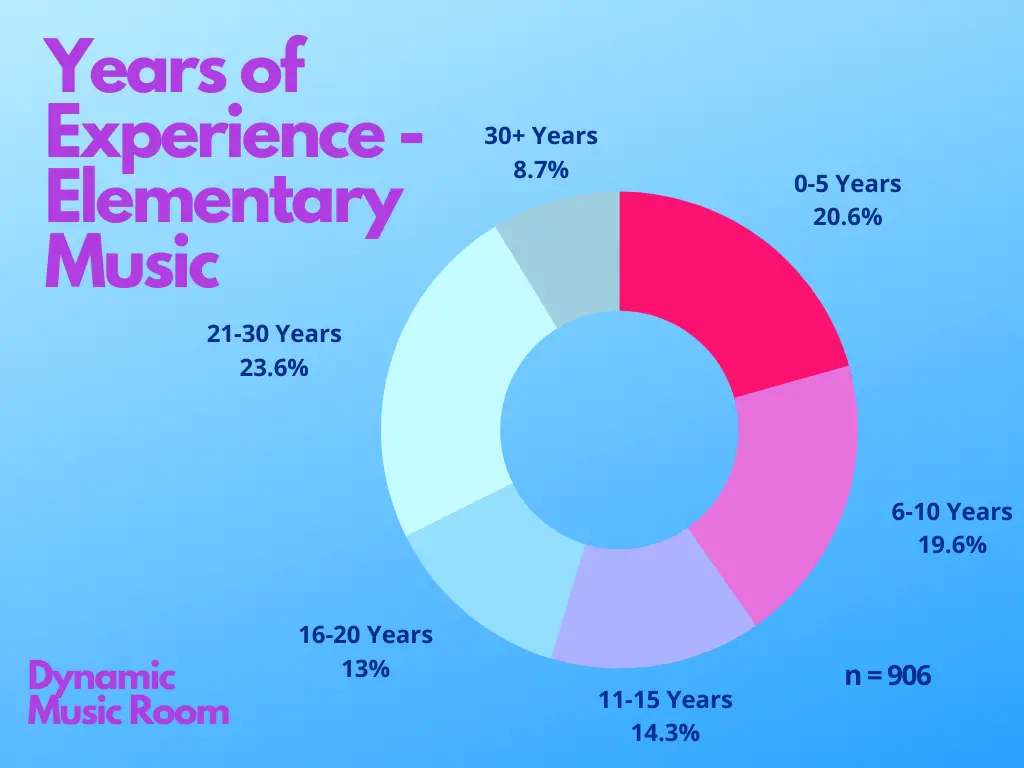
Key Takeaways:
- Teachers in their middle years (10-20) make up only a small portion (27.3%) of music teachers. This indicates a potential music teacher shortage in the elementary as the older teachers retire.
- Teachers in their beginning years (0-5) roughly equal (20.6% – 19.6%) that of teachers just past the “burnout” mark of 5 years. With an anticipated drop, we may have a shortage on this end as well.
- Teachers in the post-burnout phase (6-10) are the biggest 5-year chunk (19.6%) of music teachers. This shows grit and promise in these teachers if numbers can stay up over the years.
- 23.6% of music teachers are in the 21-30 year range. This is a smaller portion, but it’s hopeful that we won’t hit our shortage soon unless they all begin to retire early.
- Music teachers in the first third of their career make up a disproportionate percentage of the field (40.2% for what should be closer to one-third of the field). Elementary music teaching as a field is becoming more inexperienced.
- The single biggest drop is between years 6-10 and 11-15 (19.6% to 14.3%). Maybe the new “burnout” phase is actually around years 10 and 11 instead of year 5 as expected?
How Valued Does Your School Make You Feel?
Teacher burnout and frustration are important things to be aware in regard to our field.
We can notice trends over years and take steps to help when there is an issue.
The media says that teachers are unhappy in their jobs, but I suspected part of this is due to feeling undervalued, which is why I asked this question.
Here are the results:
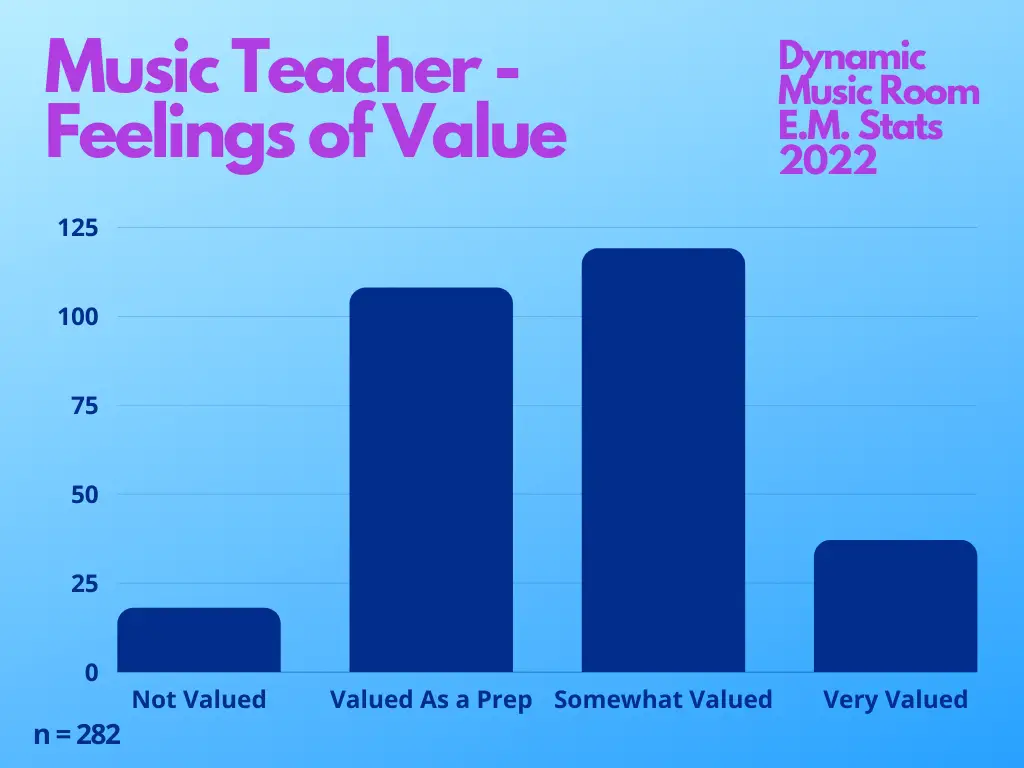
Key Takeaways:
- Over half (55.3%) of elementary music teachers still feel either somewhat valued or very valued. With the public perception of teacher unhappiness, feeling valued by the school may not be the driving force.
- Less than half (44.7%) of elementary music teachers don’t feel valued at all or valued only as a prep. Further tracking of this statistic through the years will show if this is trend and in which direction. Still, the number is high enough to cause alarm as we know feeling appreciated is inversely related to teacher burnout.
- The vast majority (80.5%) of elementary music teachers land somewhere in the middle of feeling appreciated. This may indicate that they feel left out in general or that it depends on the time of year or situation. Can our music education community do more to help shift the needle?
- One respondent brought up an interesting point: They feel valued by their school but expendable by the district at large. Potential follow-up of data based on district size may be a good idea.
How Often Were You Pulled To Sub?
My district pulls music and other special area teachers to sub all the time.
After mentioning something to others at a workshop, I was surprised to find this wasn’t the norm.
I though it was a symptom of the pandemic, but this may not be the case. Or if it is, it’s not as prevalent as I thought.
I had to know more.
Here’s what I found:
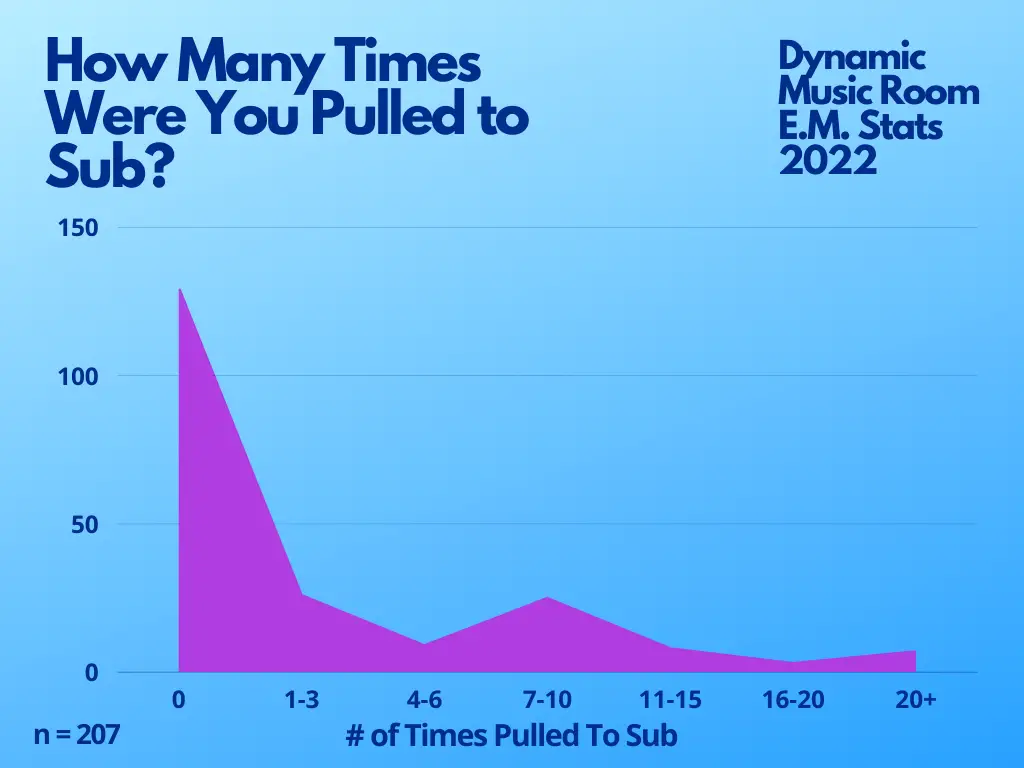
Key Takeaways:
- The majority of music teachers (62.3%) are still not getting pulled at all. Most schools are still finding ways to avoid doing it.
- Of getting pulled, there is a bump around 7-10 times per year (12.1%).
- 4.8% of music teachers have been pulled 16 times or more. Assuming 180 student days on average, we’re approaching 10% or more of their job has been a substitute teacher.
This data is important to track over the coming years, as it will show an area that may need some serious advocacy.
If the teacher shortage hits as many expect it to, this category may get worse.
Elementary Music Teacher Education Credentials/Experience
For this data, I wanted more of a baseline to further track shifts in degrees and training in music teachers over the coming years.
I know I hear and have helped general education teachers switched to teaching elementary music several times, so I was also curious how common this was.
Here’s what I found:
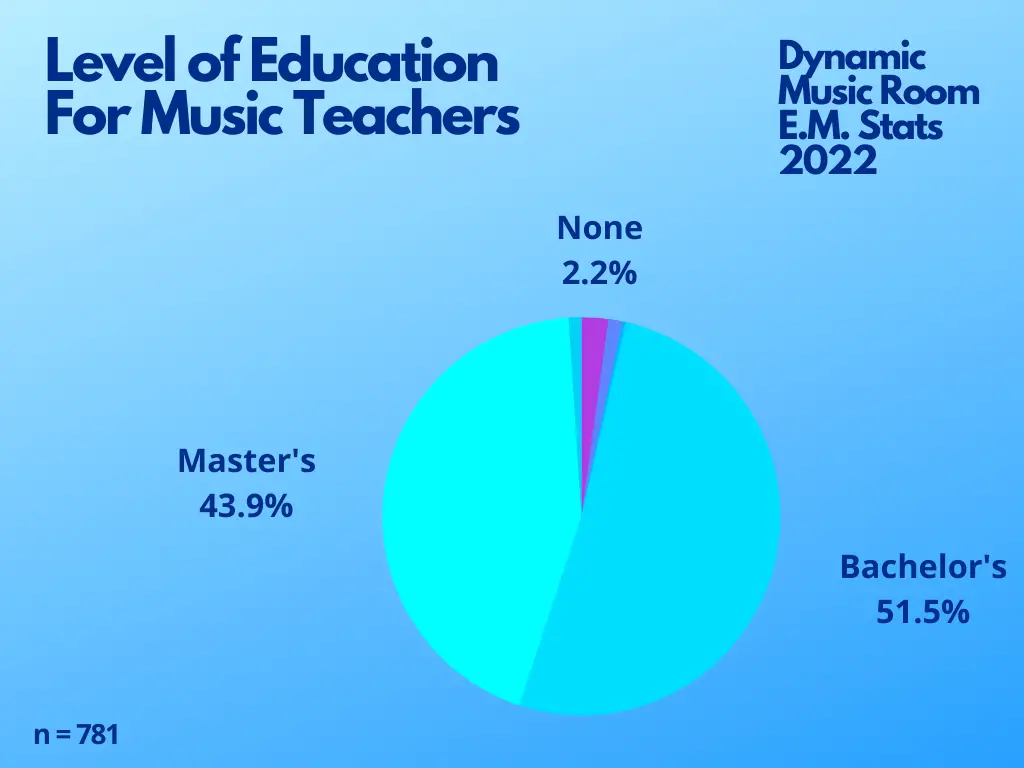
Note: This doesn’t take a look at extra method certifications such as Orff, Kodaly, etc.
Key Takeaways:
- Over half of music teachers (51.5%) have earned their Bachelor’s and not gone on to receive their Master’s (43.9%).
- 2.2% of music teachers in the elementary have no training or certification in music whatsoever. While I’m glad this number is small, it’s still too high.
- 1% of elementary music teachers have doctorates. This makes sense as most who have earned this degree are teaching at the college level.
- <1% of music teachers have only taken a few classes or earned an Associate’s degree in music.
How Many Students Do You Service?
Are music teachers asked to take on more and more students with less time to see them?
The time question was answered before with a resounding: yes, unfortunately.
Does less time equal a high volume of students? This chart gives us an idea:
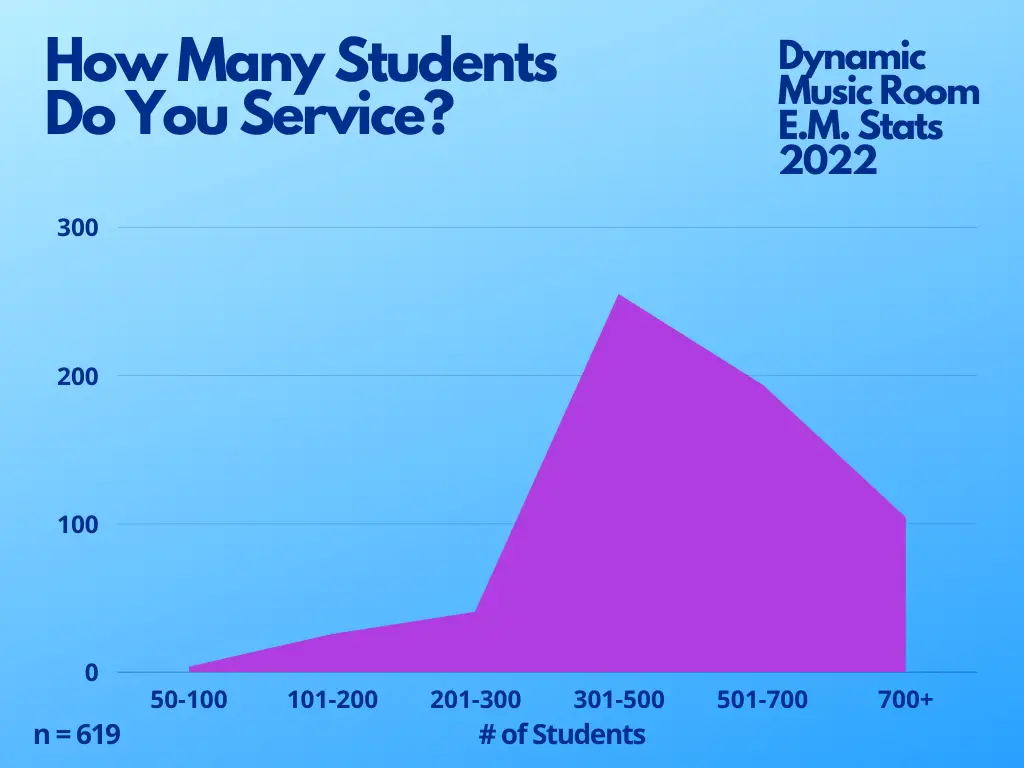
Key Takeaways:
- 41% of music teachers service 301-500 students. This is lower than I expected, but it’s still a lot of students.
- 31.2% of music teachers service 501-700 students.
- 16.8% of music teachers see over 700 students. This number is very high. Some respondents even added that they’ll see over 1,000 in a single year.
Where Do You Teach Elementary Music?
I teach at two different schools.
In one, I have a fully-stocked music room.
At the other, I share the library with the teacher who is on the opposite schedule from me.
What does the elementary music field at large have to deal with?
Here’s what I found after asking:
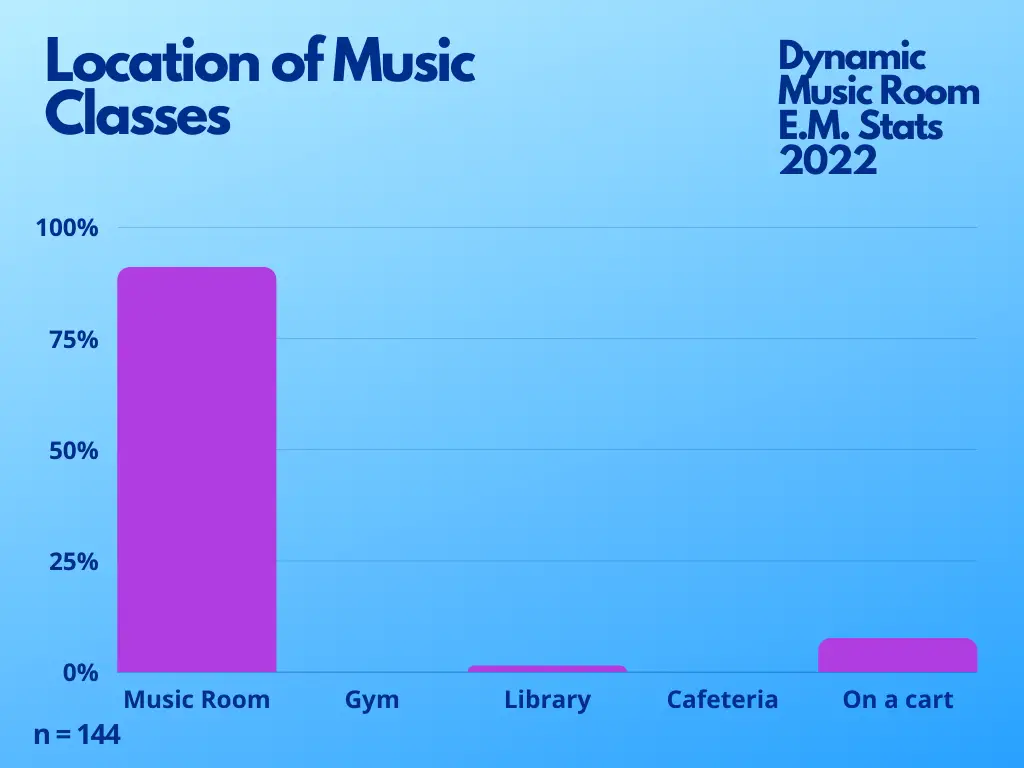
Key Takeaway:
- 91% of music teachers still get their own room. Honestly, based on the number of people who ask for help in different forums and social media groups, I expected this number to be much lower. I supposed it’s a case for perception; you only ask for help teaching on a cart if you’re in it, so it seems like it’s more.
- 7.6% of music teachers are on a cart and push into general teacher classrooms.
- 1.4% of music teachers do their classes in a library.
Summary And Conclusion
Thank you to all who responded to the surveys and questions!
It’s our goal to support music teachers of all kinds, and hopefully, this data and trends article gives us a little insight into the mind and state of elementary music education at large.
If you found something useful or interesting in this study, please share it with others and feel free to use these data sets or graphics in your own websites or articles along with an appropriate attribution back to either the Dynamic Music Room homepage or this specific post.
If you have any questions, would like to talk, or book me (Zach VanderGraaff) for an interview or presentation, please reach out to me at the email:
“dynamicmusicroomATgmailDOTcom”
Thank you and look forward to hearing from you!

